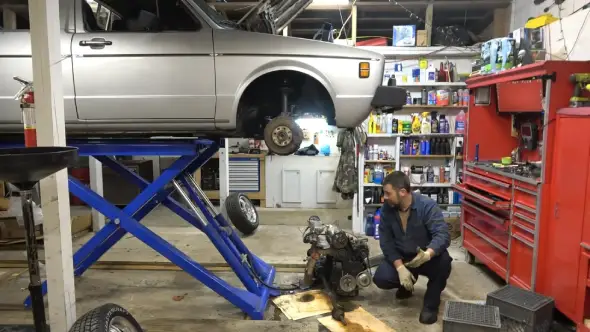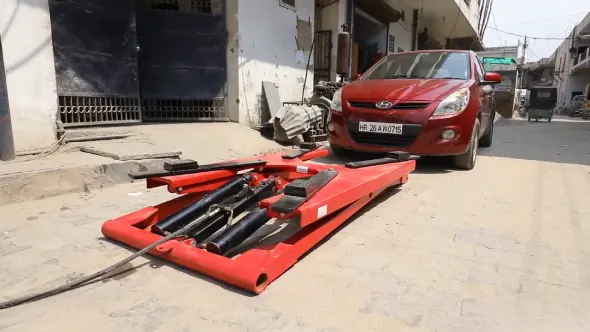Last Updated on April 5, 2023
Car scissor lifts can be a safe and helpful tool for vehicle repair when used correctly, with the correct safety measures in place. You need to adhere to the manufacturer’s instructions and safety directives or risk injury from misuse.
Cars that are lighter in weight and size are usually best suited for scissor lift hoisting. You have to consider the weight capacity of a car scissor lifts before usage. Vehicles such as trucks or SUVs that exceed this capacity could cause damage to the lift, resulting in serious harm.
You should always adhere to proper safety protocols while using a scissor lift to ensure your safety and a successful repair. Let’s dive into the risks of working with car scissor lifts, plus safety guidelines to ensure a safe experience.
Are Car Scissor Lifts Safe: Common Risks & Hazards

Car scissor lifts are awesome tools, but improper use can cause some serious headaches. Let’s explore some of the common hazards and risks involved when using a car lift. Knowledge is key to staying safe.
1. Lifting Capacity
Whenever you are using a car scissor lift, you should be aware of the lift’s weight capacity. This capacity is determined by the manufacturer and should never be exceeded.
Overloading the lift can cause the platform to malfunction or collapse, leading to severe damage or injury. It is best practice to evenly distribute the weight on the platform to reduce the risk of this occurring.
2. Stability
Another risk associated with car scissor lifts is stability. You have to place the lift on a level surface so it’ll work right. Installing incorrectly or on an uneven surface could lead to instability, tipping over, and injury or damage.
When placing a vehicle on a scissor lift, all wheels must be positioned properly so that they do not move while in use. Failure to do so could also lead to instability and create a hazard. After you’ve got the platform positioned and secured, test its stability.
3. Failure to Lock
There’s also the risk of scissor lifts not locking. If the lift isn’t locked correctly, it can lead to unexpected movement or collapse, resulting in severe injury or damage.
To reduce this risk, the lift should always be inspected for proper locking before use, and technicians should be trained on how to properly lock the lift. Also, you have to be qualified to operate the lift.
4. Pinch Points
Scissor lifts are also prone to pinch points. Pinch points can cause significant injury or amputation if fingers, toes, or other body parts get caught due to their sharp edges and small spaces.
To help avoid such a hazard, operators should always wear protective gear when operating a mid-rise scissor lift and pay careful attention when working near pinch points.
Inspecting the lift before use is important to ensure that all pinch points are properly identified and avoided while in use.
5. Electrocution Risk
Car scissor lifts are powered by electricity, which has the potential to cause severe electrocution. The risk is mainly caused by faulty, damaged, or exposed electrical connections that can cause a current to travel through the body and stop the heart.
It’s essential to perform regular maintenance on the lift’s electrical connections, such as checking for any signs of wear and tear or damage and ensuring that all connections are in good condition before using the lift.
Switching off the power supply before attempting any repairs or maintenance work is equally important.
6. Hydraulic System Failure
The hydraulic system is a critical part of car scissor lifts. Malfunctions or failures in this system can lead to sudden drops, resulting in serious injury or damage.
It is paramount that inspections are carried out routinely to check the status of the hydraulic system, looking for signs of cracks, leaks, or any other types of damage.
Also, you should only use the lift when its hydraulic system is fully functional, and safety precautions are taken into account.
Safety Measures and Guidelines for Operating Car Scissor Lifts

Operating a car scissor lift isn’t as simple as hopping in the driver’s seat and going, and safety should be your top priority. To that end, here are some helpful precautions to keep you safe while cruising around: remember proper guidelines, wear protective gear when necessary, and follow traffic laws.
Don’t let hazardous operating conditions catch you off guard, become an informed scissor lift operator so that every operation is smooth and safe.
1. Training and Certification
Safety is paramount when using a scissor lift, and proper training and certification are essential. Ensure you’re certified by an accredited institution or program to ensure you know how to use the lift safely.
Training should include instruction on how to set up, raise the lift, inspect, and maintain the lift and essential safety guidelines such as weight distribution, lift capacity, and loading procedures.
It’s also essential to learn about emergency shut-off procedures and how to respond to problems with the lifting platform.
2. Load Limits and Weight Distribution
When determining a load limit for a car scissor lift, it is critical to know the weight capacity of the best car lift itself and the amount of load that can safely be placed on its platform.
The total load should never exceed the lift’s rated capacity at any time. Aside from that, it is important to distribute weight evenly across the platform to ensure stability during operation.
Heavy objects should not be placed on one side of the platform or concentrated in one area. Use blocks or supports to divide the load across the lifting surface evenly if necessary.
3. Inspection and Maintenance
Regular inspection and maintenance of car scissor lifts are essential for safe operation. Before use, check all components, such as hydraulic systems, lift platforms, safety features, structural parts, electrical wiring, etc., for any defects or malfunctions.
If any are found, they must be reported and corrected before use. Getting a qualified technician to check all device parts according to the instructions is a good idea.
Also, regularly lubricate all moving parts with approved lubricants according to manufacturer specifications to avoid premature wear and tear on vital components.
4. Proper Use of Safety Features
When operating a car scissor lift, remember to use the safety features provided. Ensure all safety features are used as intended and manufacturer guidelines are followed.
Common safety features on car scissor lifts include emergency stop buttons, overload protection, and safety bars. These features should be checked regularly to ensure they are in good working order.
5. Personal Protective Equipment (PPE)
It is essential to wear proper personal protective equipment when using a car scissor lift. This includes items such as hard hats, safety glasses, and non-slip shoes.
Hard hats protect against debris and other objects falling from overhead, which could cause serious injury or death.
Safety glasses are necessary for protecting eyes from flying particles or sparks caused by grinding metal surfaces while on the lift platform.
Non-slip shoes help keep you stable on the lift’s platform when you may not have a secure footing due to obstacles such as oil spills or other liquids on the surface of the platform.
6. Secure the Vehicle
Before lifting a vehicle up onto a car scissor lift, you need to secure it properly so that it does not roll off or shift during the operation of the lift.
Wheel chocks and other restraints should keep the vehicle stationary while it is lifted off the ground.
Also, any loose items in and around the vehicle should be removed before using a car scissor lift for added security and stability for both yourself and your vehicle during operation time on the lift platform.
7. Proper Positioning
Properly positioning the car scissor lift platform is essential to ensure a successful and safe rise scissor lift. For a proper lift distribution, the vehicle points must be placed directly underneath the platform before any further action.
Also, make sure that the level on which you are placing the lift is even and not inclined in any way or form. Paying attention to these details will help prevent damage to both your vehicle and yourself during operation.
8. Avoid Overextension
Another key safety measure to remember when working with a car scissor lift is avoiding overextension beyond its recommended height.
Overextending the lift at excessive heights can cause instability or even breakage of certain components, thereby dramatically increasing the risk of accidents.
So, you must remain aware of the lift’s ideal working height and avoid stretching beyond that point.
Can Car Scissor Lifts be Used on all Types of Cars?

Car scissor lifts cannot lift all kinds of cars. This is because their weight capacity and lifting height vary, so it’s essential to check the specifications for the particular lift being used.
Even though they can be used on most types of cars, they are unsuitable for larger vehicles, such as trucks and SUVs, that weigh more than the scissor lift can handle.
To make sure the lift is right for the vehicle being lifted, it’s essential to read and follow the manufacturer’s instructions regarding weight capacity and lifting height.
Ultimately, understanding both vehicle size and weight, along with car scissor lift specs, will help determine if the car scissor lift is an appropriate choice for lifting any given vehicle.
What is the Weight Capacity of Car Scissor Lifts?
Regarding car scissor lifts, the weight capacity varies depending on the model and manufacturer. Most scissor lifts are designed to handle between 6,000 and 14,000 pounds.
Some models have higher weight capacities that can lift heavier vehicles. This is why it’s important to double-check the weight limit of a scissor lift before you use it and ensure your vehicle does not exceed this limit.
Exceeding the maximum weight capacity could cause serious accidents or even fatalities due to equipment failure.
How Often Should Car Scissor Lifts be Inspected?

It is important to inspect your car scissor lifts on a regular basis to ensure that they are functioning properly and safe to use.
Generally, it is recommended that scissor lifts be inspected annually or after every 1,000 hours of use, whichever comes first.
The frequency of inspections may differ depending on various factors, such as the type of lift, the amount of use it gets, and the manufacturer’s recommendations.
If you frequently use your lift or if it is used in harsh environments such as outdoor sites or manufacturing facilities with high levels of contamination or dust particles, then it is wise to inspect the lift more often than what is recommended.
The manufacturer’s instructions should always be followed when performing an inspection to ensure that any potential problems can be identified and corrected on time.
Car Scissor Lifts: Safer with Vigilance and Maintenance
In conclusion, car scissor lifts are generally safe if they are used correctly according to their intended purpose. Regularly maintaining your equipment is essential to ensure safety when operating this type of lift.
Also, you must follow the manufacturer’s guidelines and keep the lift area clear of people or objects while in use. With these considerations in mind, you can rest assured that your car scissor lift will provide you with reliable service.
